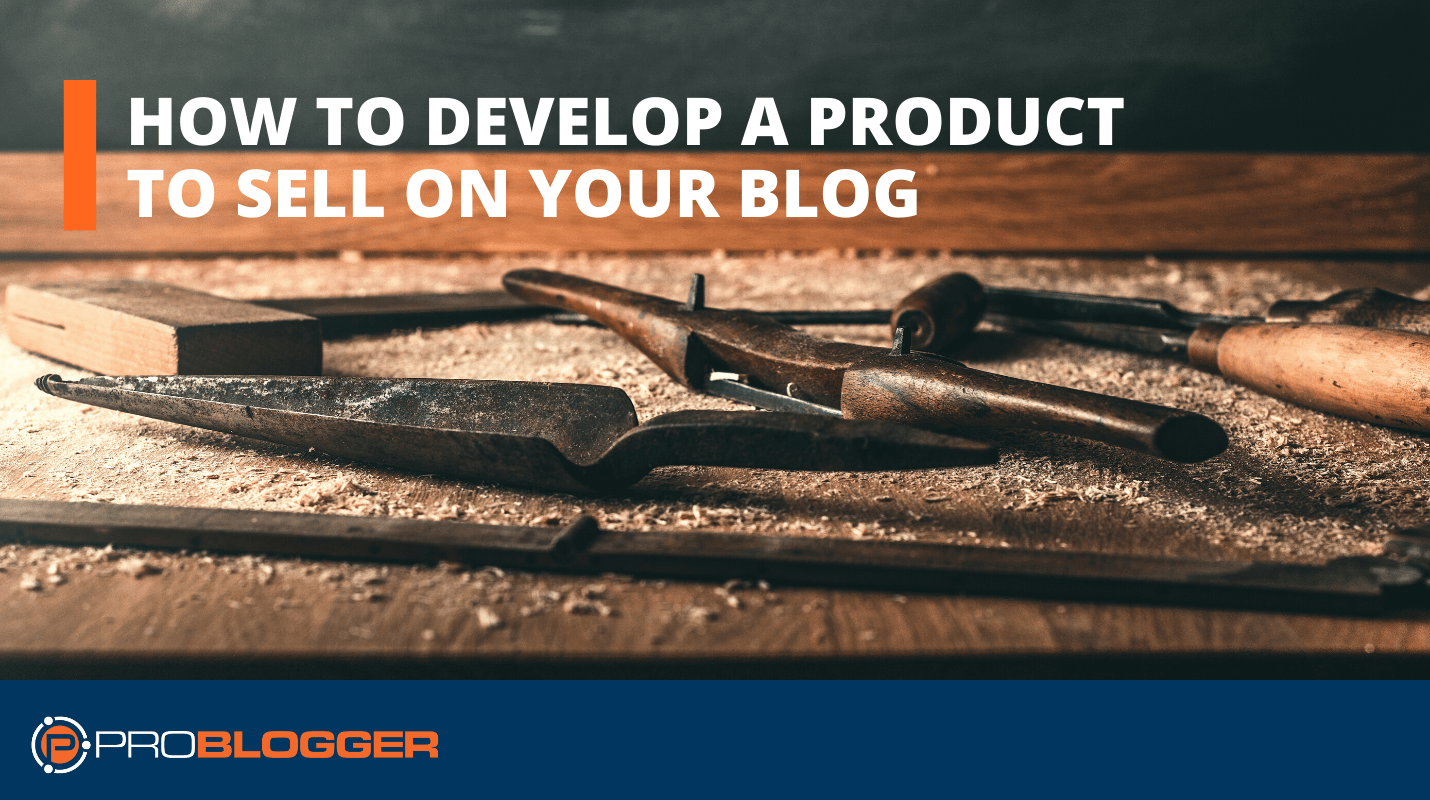How to Create Products and Sell Them on Your Blog

This post is based on episode 67 of the ProBlogger podcast.
This week I want to talk about creating a product for your blog.
Last month I talked about my various profit streams, and how nearly a third of my profits come from product sales. And that’s obviously one good reason to create and sell products – it’s a great way to monetize your blog.
But there’s another reason you should do it that goes beyond money. But before I get into that I want to tell you a little story.
A tale of two buskers
A while back my family and I were enjoying a beach vacation up in the northern parts of Australia. One night, while we were enjoying a refreshing ice cream, we came across two street performers (or ‘buskers’ as we call them here in Australia).
The first one was playing a guitar and singing, he had his guitar case open in front of him to collect loose change from passers-by. Our kids nagged us to stop and listen (they’re fascinated by street performers), and so we did. He was a good singer and a great guitar player, and we left a couple of dollars in change before moving on.
A little further down the road we came across another performer collecting loose change with his guitar case. With his honky-tonk guitar, harmonica, bells on one foot and a home-made kick drum on the other, this guy was a bit of a one-man band. But performance-wise he was similar to the performer to the first performer we’d encountered, and just as good.
But I’m guessing that second performer would have been earning at least 10 times as much as the first.
Why? Because he also had two CDs for sale – $15 for either one, or $25 for them both. And in the 15 minutes we were listening to him I saw eight people buy at least one CD. And we ended up buying both of them.
So having a product to sell was obviously helping him make more money. But what I found interesting is that people seemed to be taking him more seriously than the other guy. I overheard a couple of people commenting about how the CD’s meant he must be serious about his music. Having a product gave him credibility (as well as something to talk about with his listeners).
Those CDs also gave him another advantage – it helped people remember him. They could re-live his performance whenever and wherever they liked simply by playing his CD. And because they now knew his name they could recommend him to others, and perhaps even check out his web page and connect with him on social media.
(When I tucked my boys into bed that night, my three-year-old insisted on sleeping with one of those CDs – the ultimate testament to having a product to sell.)
Busking on your blog
When people start monetizing their blog, many of them try putting up ads. But sometimes I wonder if that’s the blogging equivalent of busking for tips. (And yes, I’ve fallen into this trap myself.)
In my experience, having a product to sell really takes things to the next level. And like our CD-selling performer, creating my own products and selling them my blogs has been rewarding in more ways than one.
The most obvious benefit is money. Whether you’re selling a book, an ebook, a membership or simply your knowledge and expertise, you can potentially make a profit (and perhaps even a living) from it.
That’s incredible!
But having a product to sell can also give you credibility. Just as people took our second busker more seriously because he had CDs to sell, people started taking me more seriously when I started selling products on my two sites.
And that credibility can lead to all kinds of opportunities. Within 24 hours of releasing my first ebook I was approach by a publisher who wanted to publish it. And while the content of the ebook obviously helped attract their attention, I believe the credibility and authority I gained from creating it in the first place also influenced their decision to approach me. (I honestly don’t think it would have happened otherwise.)
It can also lead to deeper relationships with your readers. As people worked through my 31 Days to Build a Better Blog ebook they often sent me emails and tweets along the way, creating an ongoing relationship. And that kind of thing can lengthen and deepen the relationship you have with your readers.
Heavy traffic ahead
Launching a new product can also create a spike in your site’s traffic, whether it’s from:
- the emails you sent
- affiliates promoting your product
- word of mouth.
Whenever we launch a product we know we’ll be getting a lot of traffic that month, which creates other ongoing benefits for our site.
Other benefits
Here are two more quick benefits of creating your own products:
- You’ll probably learn a new skill or two along the way simply because you’re going beyond what you’d normally do. And learning new skills is always a good thing.
- You’ll start thinking about your topic in a way you perhaps haven’t thought about it before. When I was approached by the publisher to write the first ProBlogger book I’d already been blogging about blogging for a while. But having to write an entire book about it forced me to think about it in a deeper, ‘big picture’ way.
Stop dreaming, and start doing
Most bloggers agree that creating and selling products is a great idea. But ask them about actually creating those products and you’ll hear a variety of excuses as to why now isn’t the right time for them.
And I can say that because I’m one of those people.
When I started Digital Photography School in 2007, I dreamed monetizing that blog with an ebook. And having promoted other people’s ebooks on that blog I had a pretty good idea about the topics I wanted to cover.
But I also had a long list of excuses as to why I couldn’t write it.
- We had a newborn baby in the house, and so I had no spare time.
- I was also sleep deprived, and so I wasn’t thinking clearly enough.
- I didn’t know how to write, edit or design an ebook.
- I didn’t know which shopping cart to use.
- I didn’t know what marketing tactics to use.
- No-one would buy it because I wasn’t a professional photographer.
And those excuses held me back for two years.
In 2009, having decided I needed to either kill the idea or act on it, I started spending 15 minutes each day on it. First came the planning, and then the writing and editing. When it was done I started looking for a designer while researching shopping carts. And towards the end I spent those 15 minutes writing marketing copy, sales pages, and sales emails.
Three and a half months later everything was ready, and I sent the launch email out to my readers.
Around ten minutes later I received an email telling me I’d made my first $15 sale. And ten or so minutes after that another email came in. I’d made $30, and I was excited. Admittedly it wasn’t a great return for three months’ work, but I was still proud of myself.
Eight minutes later the next sale came in. Five minutes after that, the next sale came in. They started coming in every three minutes, then every two minutes, and then every minute. Soon they were coming in every 30 seconds, and then every 10 seconds. I can still remember waking up my wife at 3am and saying, “You wouldn’t believe what’s going on in my inbox”.
It went on to make US$72,000 in 10 days.
Yes, it was great to be making that kind of money. But it was also great to know my readers would buy something I created. And it was great knowing I had the skills and the ability to get it done.
Since then we’ve created something like 40 products. In some ways creating new products becomes easier because you have more skills and more confidence in yourself. But in other ways it becomes more difficult because you start thinking, I don’t actually need to create anything else because I already have products that are selling quite well.
But need to fight against that complacency and keep creating products. Because one of those products could be just what your readers have been waiting for.
Your first product
Some of you might be thinking, I’d love to create a product I can sell on my blog. But I have no idea what it could be. So here are some tips to help you create your first product.
Solve a problem. What are the top three problems your readers are having? What kind of help do they need? Creating a product that solves those problems and provides that help could be a great place to start.
Build on content you already have. Creating a new product from scratch can be quite overwhelming. So why not reduce your workload by basing it on content you’ve already created? cut down the work?
Now this may sound like cheating. But as long as you’re upfront with your readers, and include new content along with the content you’ve already published, it can be a great way to start the ball rolling with your first product.
Test your idea on your blog. Got an idea for a product, but aren’t sure people will be interested? Write a few blog posts on the idea and see what the reaction is like. If people seem interested, you can then use those posts as the cornerstone of your new product.
See what others in your niche are doing. Check out what products other people in your niche are selling. This will give help you decide what types of products are worth creating, along with what topics they should cover.
Become an affiliate for other people’s products. Promoting your competitors’ products might sound a little strange. But signing up as an affiliate means you can earn a little extra money while learn:
- whether your readers will respond to that type of product
- the ideal price point to target
- how to best promote a product for sale.
Start small. What product would be the quickest and easiest for you to create? It could be a small ebook, a short course, or even a quick guide people can print out and keep on their desk. You may not make a fortune from each sale. But you will pick up some new skills (and a lot of confidence), and get your readers used to the idea of buying things from your blog.
Take it one step at a time. The thought of creating an entire product can be overwhelming. So break it down into lots of small tasks you can tackle one at a time. When I wrote my first book, I broke the process down into a series of steps: planning, writing, editing, design, research, and so on.
Creating small tasks made them easier to complete. (I only had 15 minutes a day to work on them.) It also meant I could tick them off as I went, and make it feel like I was making real progress.
Make the time. While breaking the process up into small tasks is a great idea, you still need to make the time to complete them. It might be 15 minutes a day, or one full day each weekend. Whatever you decide, try to maintain a schedule so you keep making progress. It will be worth it in the end.
As I mentioned earlier, we now have 40 products available on the two blogs. And since 2009 we’ve probably sold half a million products. But none of it would have happened if I hadn’t pushed myself to create that first ebook.
What product will you be creating for your blog? Let us know in the comments.
Image credit: Photo by Alexander Andrews on Unsplash







